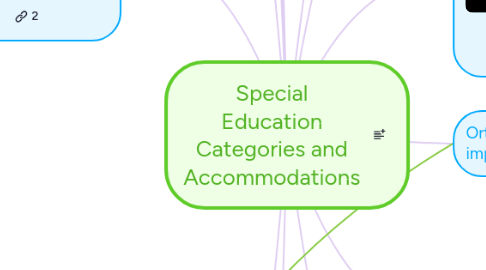
1. Deaf-blindess
1.1. Acommodatios or modifications
1.2. Definition
2. Deafness
2.1. Acommodatios or modifications
2.2. Definition
3. Emotional Disturbance
3.1. Acommodatios or modifications
3.2. Definition
3.3. Inability to learn
3.3.1. cannot be explained by intellectual, sensory or health factors.
3.4. an inability to build or maintain satisfactory interpersonal relationships with peers and teachers
3.5. inappropriate types of behavior or feelings under normal circumstances
3.6. a general pervasive mood of unhappiness or depression
3.7. a tendency to develop physical symptoms or fears associated with personal or school problems
3.8. Intervention:
3.9. Case study: Megan
4. Hearing Impairment
4.1. Acommodatios or modifications
4.2. Definition
5. Intellectual disability
5.1. Acommodatios or modifications
5.2. formerly known as Mental Retardation
5.3. Definition
6. Multiple disabilities
6.1. Acommodatios or modifications
6.1.1. Technology can be incorporated as a tool
6.2. Definition
7. Orthopedic impairment
7.1. This also affected Rita
7.2. Accommodations or modifications
8. Other health impariments
8.1. Acommodatios or modifications
8.2. Definition
8.3. Examples:
8.3.1. ashma
8.3.2. ADD or ADHD
8.3.3. diabetes
8.3.4. epilepsy
8.3.5. heart condition
8.3.6. hemophilia
8.3.7. lead poisoning
8.3.8. leukemia
8.4. Strategies
9. Specific lerning disability
9.1. Acommodatios or modifications
9.2. Definition
9.3. Imperfect ability to:
9.3.1. Listen
9.3.2. think
9.3.3. speak
9.3.4. read
9.3.5. write
9.3.6. spell
9.3.7. mathematical calculations
9.4. some conditions:
9.4.1. perceptual disabilities
9.4.2. brain injury
9.4.3. minimal brain dysfunction
9.4.4. dyslexia
9.4.5. developmental aphasia
9.5. not learning problems that are the result of:
9.5.1. visual, hearing or motor disabilities
9.5.2. mental retardation
9.5.3. emotional disturbance
9.5.4. environmental disadvantage
9.5.5. cultural disadvantage
9.5.6. economic disadvantage
9.6. Case study: Nick
9.7. Case Study: Ellie
10. speech or language impairment
10.1. Acommodatios or modifications
10.2. Definition
10.3. communication disorder
10.3.1. stuttering
10.3.2. impaired articulation
10.3.3. language impairment
10.3.4. voice impairment
11. Developmental delay
11.1. Acommodatios or modifications
11.2. Definition
11.3. can be on the following areas:
11.3.1. physical development
11.3.2. adaptive (behavioral) development
11.3.3. social or emotional development
11.3.4. communication
11.3.5. cognitive development
12. Autism
12.1. Acommodatios or modifications
12.1.1. Shadow teacher
12.1.2. ABA therapy
12.2. Case study
12.2.1. Isabelita
12.3. Definition
13. Traumatic Brain Injury
13.1. Accommodations or modifications
13.1.1. Shadow teacher
13.1.2. Learning disability
13.1.2.1. role play
13.1.2.2. use models and demonstrations
13.1.2.3. Provide visuals in lectures
13.1.3. Communication
13.1.3.1. AAC devices
13.1.3.2. Provides more visuals
13.1.3.3. use translator-interpreter
13.1.4. Emotional-Behavioral
13.1.4.1. peer group
13.1.4.2. service learning
13.1.4.3. teaching behavioral management
13.1.4.4. Positive-behavioral support
13.1.5. Intellectual disability
13.1.5.1. paraprofessionals
13.1.5.2. using technology to deliver information
13.1.5.3. Community based instruction
13.1.5.4. extended time
13.1.6. Health impairments and physical disability
13.1.6.1. AAC devices
13.1.6.2. Wheelchairs/kinesthetic aids
13.1.6.3. utilize NIMAS
13.1.6.4. Adaptive physical education
13.1.7. TBI
13.1.7.1. Technology to aid memory
13.1.7.2. Mnemonic strategies
13.1.7.3. Multiple formats of information
13.1.7.4. Breaks and down-time
13.1.7.5. make tests more simple
13.1.7.6. Provide a scribe
13.1.7.7. Modified textbook
13.1.7.8. Provide textbook that student can write in
13.2. Case study
13.2.1. Rita
13.3. Definition
13.4. The term applies to open or closed head injuries resulting in impairments in one or more areas, such as:
13.4.1. cognition
13.4.2. language
13.4.3. memory
13.4.4. attention
13.4.5. reasoning
13.4.6. abstract thinking
13.4.7. judgment
13.4.8. problem-solving
13.4.9. sensory, perceptual and motor abilities
13.4.10. psychosocial behavior
13.4.11. physical functions
13.4.12. information processing
13.4.13. speech
14. Shadow Teacher
15. Visual Impairment Including bilndness
15.1. Acommodations or modifications
15.1.1. Changes made in the way materials are presented
15.1.1.1. Copies of overhead projector/smart board activities to be viewed at his/her desk as needed.
15.1.1.2. The teacher or presenter should verbalize all information as it is written on the board or overhead.
15.1.1.3. Information presented on the board should be in a high contrast color.
15.1.1.4. Use recorded text as needed.
15.1.1.5. Classroom recording of lectures/instruction by student.
15.1.1.6. Large Print textbooks/materials.
15.1.1.7. Braille textbooks/materials.
15.1.1.8. Clear, dark copies of worksheets.
15.1.2. Changes in the way students demonstrate learning
15.1.2.1. Avoid activities requiring extensive visual scanning.
15.1.2.2. Avoid visually cluttered materials.
15.1.2.3. Allow students to use (bold marker, 20/20 pen, mechanical pencil, or other unique writing tool) to complete assignments.
15.1.2.4. Use of bold line paper.
15.1.2.5. Use of raised line paper.
15.1.2.6. Oral testing.
15.1.3. Changes in the Setting: Environment
15.1.3.1. Open and close doors fully (a half open door can be a dangerous obstacle).
15.1.3.2. Eliminate unnecessary background noise. Consider isolation headphones.
15.1.3.3. Eliminate clutter from the room, particularly in aisles and movement paths
15.1.3.4. Use of task lighting as needed.
15.1.3.5. Place materials in consistent places so that students know where particular items are always located.
15.2. Definition
15.3. The term includes:
15.3.1. partial sight
15.3.2. blindness
